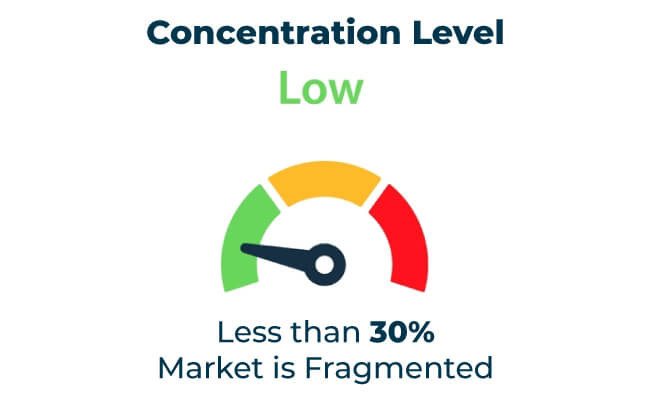Pyramid tea bag manufacturers are changing the face of the tea industry through their innovative, eco-friendly, and consumer-centric products. The focus is on premium materials and advanced packaging design to meet the emerging demands of the consumers in terms of flavor retention and convenience.
The pyramid tea bags market is expected to grow at a compound annual growth rate of 4.5% in the next eight years to exceed USD 437 million by 2035. Companies are focusing on sustainability, product innovation, and rapid production to align with changing consumer and industry needs.
| Attribute | Details |
|---|---|
| Projected Value by 2035 | USD 437 million |
| CAGR during the period 2025 to 2035 | 4.5% |
The market is experiencing a surge in demand as consumers seek high-quality, sustainable tea bag solutions. Advances in biodegradable materials and unique pyramid designs ensure maximum flavor infusion and eco-conscious consumption. Collaboration with tea producers and retailers strengthens adherence to quality standards and market expectations
Exclusive Offer: 30% Off on Regional Reports
Get a free sample report and customize your regions for a 30% discount on your regional report!
| Category | Market Share (%) |
|---|---|
| Top 3 Players (Twinings, Lipton, Tetley) | 13% |
| Rest of Top 5 Players (Dilmah, Harney & Sons) | 08% |
| Next 5 of Top 10 Players | 04% |
| Type of Player | Market Share (%) |
|---|---|
| Top 10 Players | 25% |
| Next 20 Players | 42% |
| Remaining Players | 33% |

Year-on-Year Leaders
Check Free Sample Report & Save 40%!
Select your niche segments and personalize your insights for smart savings. Cut costs now!
Tremendous growth potential remains for pyramid tea bags in Asian-Pacific, Africa and Latin America due to growing consumer incomes, enhancing the culture for tea, as well as in premium product requirements. In regions these also look out for sustainable yet premium quality package offerings.
In-House vs. Contract Packaging
| Region | North America |
|---|---|
| Market Share (%) | 35% |
| Key Drivers | Focus on sustainability and premium tea options. |
| Region | Europe |
|---|---|
| Market Share (%) | 30% |
| Key Drivers | High adoption of eco-friendly practices and specialty teas. |
| Region | Asia-Pacific |
|---|---|
| Market Share (%) | 25% |
| Key Drivers | Rising tea culture and preference for premium products. |
| Region | Other Regions |
|---|---|
| Market Share (%) | 10% |
| Key Drivers | Affordable and sustainable solutions attract emerging markets. |
The pyramid tea bags market will continue to expand with sustainability, innovation, and automation at the forefront. Companies that leverage AI to optimize production, focus on eco-friendly designs, and cater to emerging markets will lead the industry. Collaboration with tea producers and e-commerce platforms will further strengthen market positioning..
| Tier | Key Companies |
|---|---|
| Tier 1 | Twinings, Lipton, Tetley |
| Tier 2 | Dilmah, Harney & Sons |
| Tier 3 | Kusmi Tea, Mighty Leaf Tea |
The pyramid tea bags market promises tremendous growth owing to premiumisation, sustainability and consumer demand. The companies adopting eco-friendly solution, flavor development, and new-age packaging will lead in this dynamic business environment. Integration of automation with AI will drive efficiency and individuality, maintaining market leadership with pioneers.
Key Definitions
Abbreviations
Methodology
This report integrates primary research, secondary data, and expert insights. Analysts validated findings through interviews with industry professionals and end-users. The methodology ensures a comprehensive and accurate market perspective.
The pyramid tea bags market encompasses the production and development of triangular tea bags designed for premium tea consumption. These bags address consumer demands for convenience, sustainability, and enhanced flavor infusion.
Pyramid tea bags allow tea leaves to expand fully, enhancing flavor and aroma. Their design also accommodates larger, premium-quality tea leaves.
Biodegradable tea bags reduce waste and environmental impact, meeting the rising demand for sustainable packaging
Europe leads in sustainability-focused growth, while Asia-Pacific offers immense potential due to its tea culture and rising disposable incomes
High production costs for sustainable materials, regulatory compliance, and consumer price sensitivity remain significant hurdles.
Smart packaging with QR codes, flavor-enhancing mesh designs, and energy-efficient production techniques are transforming the market.
Explore Packaging Formats Insights
View Reports
Thank you!
You will receive an email from our Business Development Manager. Please be sure to check your SPAM/JUNK folder too.